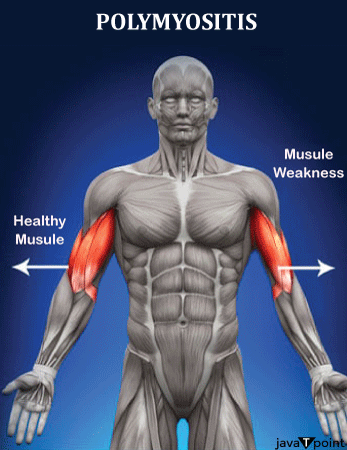PolymyositisAn inflammatory muscle condition called polymyositis results in muscular weakening. Muscle inflammation is referred to as myositis. Typically, the muscles closest to the body's trunk are affected by polymyositis. Polymyositis patients eventually have trouble standing up from a seated posture, ascending stairs, lifting objects, or reaching aloft. As the condition worsens, it can occasionally spread to muscles far from the body's trunk. 
Polymyositis steadily worsens over time, rarely affecting anyone under the age of 18. By about a 2:1 ratio, women are more likely to have it. Dermatomyositis is the term used if the disorder is accompanied by an inflammatory process that also affects the skin. It is possible for polymyositis to coexist with other diseases. There have been cases where dermatomyositis and polymyositis have been linked to malignancies like lymphoma, breast, lung, ovarian, and colon. What causes Polymyositis?Although the exact origin of polymyositis is unknown, there are signs that hereditary factors may contribute to the condition. According to recent studies, the illness might manifest as an autoimmune process in which immune system cells invade and damage muscle tissue. Knowledge regarding the causes of polymyositis may increase as a result of research into how the immune system functions and what causes it to malfunction. What are the symptoms of Polymyositis?Here are a few signs and symptoms of polymyositis. These signs may appear and disappear:
Diagnosis and TestsHow is polymyositis diagnosed?Blood tests and a doctor's examination are typically the first steps in the disease's diagnosis. Muscle enzyme levels are frequently unusually high in people with polymyositis. Muscle that is being harmed by inflammation produces the enzymes and releases them into the circulation. Regular blood and urine tests can check for abnormalities in the internal organs. To look for indications of malignancies that may develop with polymyositis, srceening exams such chest X-rays, mammograms, PAP smears, and others may be taken into consideration. Other disorders that resemble polymyositis can be ruled out with additional testing. Electrical testing of muscles and nerves, such as electromyography (EMG) and nerve conduction velocity studies, can reveal aberrant results that are diagnostic of polymyositis. Additionally, these testing can rule out other nerve-muscle illnesses. Muscle inflammation can be seen on images of the muscles, which can also be used to locate potential locations for muscle biopsies. A surgical procedure called a muscle biopsy involves removing and analysing muscle tissue. To confirm the presence of muscle inflammation specific to polymyositis, a muscle biopsy is performed. Treatment of PolymyositisTypical therapies include:
How is Polymyositis treated?High doses of corticosteroids are used as a first line of treatment for polymyositis. Because they can successfully reduce the inflammation in the muscles, corticosteroids are administered. Polymyositis is not always sufficiently alleviated by corticosteroids. Immunosuppressive drugs are taken into consideration for these patients. These medications consist of:
The intravenous infusion of immunoglobulins (IVIG) has proven to be a successful treatment for severe polymyositis cases. The use of physical therapy is crucial in the management of polymyositis. Patients with polymyositis can thrive if they receive early medical therapy for the condition and disease flare-ups. When the condition is typically inactive, the patient can concentrate on muscular rehabilitation.
Next TopicBrain Chemicals
|
 For Videos Join Our Youtube Channel: Join Now
For Videos Join Our Youtube Channel: Join Now
Feedback
- Send your Feedback to [email protected]
Help Others, Please Share









